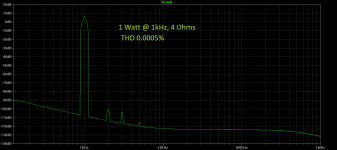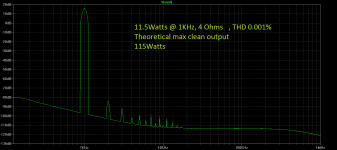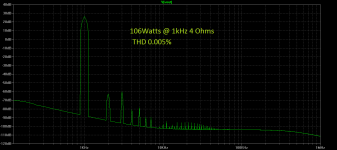This is an assumption of yours and is incorrect! Sheesh.
It's not an assumption, is it an observable fact. Not everyone interprets sound, taste, smell in exactly the same way. We see it all around us.
It's not an assumption, is it an observable fact. Not everyone interprets sound, taste, smell in exactly the same way. We see it all around us.
You are right, but I think there's the possibility that Atmasphere misinterpreted
what you wrote.
😎
There's a lot of gamesmanship surrounding getting the numbers low. And that's fine, it's interesting from an intellectual standpoint. It doesn't change the sound, but we all have various reasons for doing what we do. I'm interested in getting -100dB out of a tube power amp just for the sheer challenge.
SY
To get -100dB THD from tube amp is pretty possible , but I think that idea automatically exclude any OPS topology which use OPT,
and to use only some type of OTL-OPS altogether with some tube voltage gain stage configuration with lot of inserted GNFB .
For example , In early 50` Julius Futterman shows that his OTL tube amp was stable even with 60dB of inserted GNFB .
but today of course other modern approaches & solutions exist to reach that -100 dB goal .
You are right, but I think there's the possibility that Atmasphere misinterpreted
what you wrote.
😎
Anything is possible...Thanks.
Just get out your wallet and join the club.
It's more awaiting the delivery of my round tuit order
Although he did it I believe primarily as a stunt, Bruno Putzeys did apply a good deal of global feedback around a tube power amp with an output transformer. The problem was the tube characteristics drifted enough that stability was difficult to maintain, but while it worked people who heard it evidently were favorably impressed (this my recollection of his Linear Audio article The F-Word).SY
To get -100dB THD from tube amp is pretty possible , but I think that idea automatically exclude any OPS topology which use OPT,
and to use only some type of OTL-OPS altogether with some tube voltage gain stage configuration with lot of inserted GNFB .
For example , In early 50` Julius Futterman shows that his OTL tube amp was stable even with 60dB of inserted GNFB .
but today of course other modern approaches & solutions exist to reach that -100 dB goal .
Of course it is easier without the output transformer.
You can observe what's in my head?? You're doing better than I am 🙂It's not an assumption, is it an observable fact. Not everyone interprets sound, taste, smell in exactly the same way. We see it all around us.
There is of course no accounting for taste, but that was not what I was talking about. You may prefer something that sounds bright; I've no problem with that at all.
The problem I have is that if you have a SS amp with high feedback, the chances are much better than not that it will have a coloration called brightness (I can count on one hand the amps I've heard over the years that didn't). That brightness you may like, but it is caused by distortion due to how our ears interpret non-clipping distortions, in particular higher ordered harmonics.
Now some people like the 2nd harmonic associated with tubes (although that has a lot to do with topology employed in the tube circuit); that is a taste thing, but all humans hear that 'warmth' (distortion) the same way.
All humans do use the same perceptual rules. What we do with what we hear and what we like is an entirely different matter. I am hoping that the two are not being conflated; I see that a lot.
You can observe what's in my head?? You're doing better than I am 🙂
There is of course no accounting for taste, but that was not what I was talking about. You may prefer something that sounds bright; I've no problem with that at all.
The problem I have is that if you have a SS amp with high feedback, the chances are much better than not that it will have a coloration called brightness (I can count on one hand the amps I've heard over the years that didn't). That brightness you may like, but it is caused by distortion due to how our ears interpret non-clipping distortions, in particular higher ordered harmonics.
Now some people like the 2nd harmonic associated with tubes (although that has a lot to do with topology employed in the tube circuit); that is a taste thing, but all humans hear that 'warmth' (distortion) the same way.
All humans do use the same perceptual rules. What we do with what we hear and what we like is an entirely different matter. I am hoping that the two are not being conflated; I see that a lot.
First, the distortion needs to be audible. Not all ss/class d amps produce audible higher order distortion.
Second, what is your metric for "brightness"? Like "euphonic", "dark", "smooth", etc., it seems to be subjective. Perhaps not everyone who hears a ss amp would call it "bright". That's a matter of interpretation.
Third, it would seem your argument that tubes are "best" comes down to "my distortion is better than yours"....I would rather my amp produced distortion that was inaudible.
Seems the large number of people who prefer ss or class d indicates either: there are amps that don't produce audible amounts of these higher order distortions, or not enough to matter, and/or it really isn't perceived by many to be as as bad as you make it out to be. Or maybe some combination of all of the above.
No doubt tube amps have their fan base but so do other amp topologies. I wouldn't say there is something superior about tubes either subjectively or objectively. They are just another flavor.
Last edited:
The problem I have is that if you have a SS amp with high feedback, the chances are much better than not that it will have a coloration called brightness (I can count on one hand the amps I've heard over the years that didn't). That brightness you may like, but it is caused by distortion due to how our ears interpret non-clipping distortions, in particular higher ordered harmonics.
Really? Which harmonics and at what level cause this brightness you keep hearing? I'm interested in knowing what you consider the audibility limits of these harmonics.
Personally, I find the comments from the anti-feedback contingent requesting more focus on psycho acoustics amusing.
Is it just me, or wouldn't the simplest hypothesis (Occam's Razor) be that all of the preferences towards all amplifiers (obviously including those designed with audible distortion) be purely illusory, i.e. completely uncorrelated with any known or even yet discovered audio property?
Yes, I know I am a never ending skeptic, and I can handle the tough "why are we here question" which I can't say for most people, but I already believe people are "hearing" the look of tubes, the pricetag, the aesthetic design, or randomly equating some degradation in sound with a preference.
Is it just me, or wouldn't the simplest hypothesis (Occam's Razor) be that all of the preferences towards all amplifiers (obviously including those designed with audible distortion) be purely illusory, i.e. completely uncorrelated with any known or even yet discovered audio property?
Yes, I know I am a never ending skeptic, and I can handle the tough "why are we here question" which I can't say for most people, but I already believe people are "hearing" the look of tubes, the pricetag, the aesthetic design, or randomly equating some degradation in sound with a preference.
Last edited:
The problem is that whatever feedback does to make the sound 'artificial' is not easily measured with even the best THD equipment. We have known this for at least 30 years. You just have to LISTEN and compare.
The problem is that whatever feedback does to make the sound 'artificial' is not easily measured with even the best THD equipment. We have known this for at least 30 years. You just have to LISTEN and compare.
What's the point of going back to the THD straw man? Does that make this the 3rd or 4th circle?
What's the point of going back to the THD straw man? Does that make this the 3rd or 4th circle?
We must have gotten to the ninth circle by now.
We must have gotten to the ninth circle by now.
FedUpBack 😀
Yes we are all caught up in one giant, 'global' feedback loop and are apparently under compensated. Oscillations have been detected.

I love to measure, it's just that what I measure with THD is not giving me enough REAL information to make better products, that I am sure are still possible. I, too, can measure down to -140dB, so what? I am very disappointed after my investment in the test equipment that I get so little to work with.
When we look at THD we look at the voltage, but what really drives is the current the speakers source/sinks to the common ground, maybe this ability to deliver the demanded current witt out any rail sag or GND modulation is of far greater importance than the THD digits.
I find the OPS and how the output transistors are driven of an enormous influence on the listening results, but not much on the measurements. Currently I run 8 pairs of bjts for an amp of +-60V. Compare that to the same circuit with two pairs, then listening shows much better performance, while measurements are close to identical.
Fact is that measurements can be used to se if things works as expected, but for evaluation of musical performance the value of measurements is close to zero.
I find the OPS and how the output transistors are driven of an enormous influence on the listening results, but not much on the measurements. Currently I run 8 pairs of bjts for an amp of +-60V. Compare that to the same circuit with two pairs, then listening shows much better performance, while measurements are close to identical.
Fact is that measurements can be used to se if things works as expected, but for evaluation of musical performance the value of measurements is close to zero.
You can observe what's in my head?? You're doing better than I am 🙂
There is of course no accounting for taste, but that was not what I was talking about. You may prefer something that sounds bright; I've no problem with that at all.
The problem I have is that if you have a SS amp with high feedback, the chances are much better than not that it will have a coloration called brightness (I can count on one hand the amps I've heard over the years that didn't). That brightness you may like, but it is caused by distortion due to how our ears interpret non-clipping distortions, in particular higher ordered harmonics.
Now some people like the 2nd harmonic associated with tubes (although that has a lot to do with topology employed in the tube circuit); that is a taste thing, but all humans hear that 'warmth' (distortion) the same way.
All humans do use the same perceptual rules. What we do with what we hear and what we like is an entirely different matter. I am hoping that the two are not being conflated; I see that a lot.
Interesting - I have always experienced good, high feedback ss amps as 'neutral , and many tube amps (often low/no) fb as 'warm' or 'colored'.
(Except a few 'engineered' amps like Bob Cordell's tube amp or Bruno's 'flight of fancy' - these were as neutral as the best ss).
I agree with you that perception is a very personal thing and can vary wildly from one guy to the next. But that also means that your perception of brightness of ss is personal and not some universal fact. Just as my perception of warmth of some tube amp is personal for me.
My reference for accuracy and transparency is a ss amp, apparently your ref is a tube amp.
None of this is earth-shattering but I find it worthwhile to 'ground' our views once in a while.
Jan
Your right about non linearity of some devices and built-in 'feedback' and being closer to the original within boundaries of clipping and rules of feedback use , however Jan , wraps it up below. As mentioned earlier in the thread due to dynamics of transducer and reproduced signal, some may go with 2. However if all matters are addressed properly others prefer 1, mostly below clipping, on onset of clipping all guarantees become void for most equipment😉False premise. All devices are always nonlinear. Most devices have some built-in feedback.
However, if the situation you describe were possible then 'nonlinear plus feedback' would be closer to the original signal than 'nonlinear without feedback'. Which would sound "better" depends on the personal taste and goals of the listener: sound reproduction or a pleasing sound production?
1 has scope for hard non-linearity like clipping. As long as you avoid clipping, 1 is better. At clipping, 2 may be better.
Very, very general - depends on a host of other issues.
Jan
Cheers 😎Intriguing! But, ehh, don't you want to switch M3 and M4?
Jan
Last edited:
Heres a sample to put Nelsons pirate rules to the test.
Sample1: 1 watt
Sample 2: 10% output power
Sample 3: Close to full power
1. Would one say that this is a good sounding amplifier ?
2. Does this amplifier use feedback ?
3. What type of amplifier is this ?
Sample1: 1 watt
Sample 2: 10% output power
Sample 3: Close to full power
1. Would one say that this is a good sounding amplifier ?
2. Does this amplifier use feedback ?
3. What type of amplifier is this ?
Attachments
- Home
- Amplifiers
- Solid State
- Global Feedback - A huge benefit for audio


